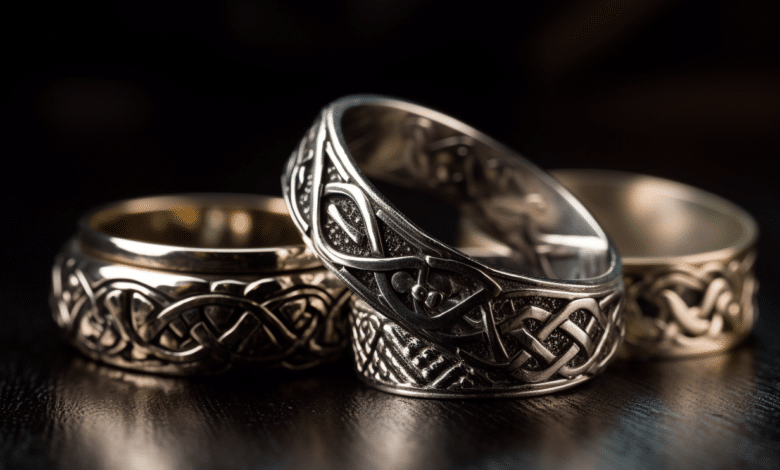7 Essential Celtic Ring Traditions Explained

In the ancient world, rings were more than just ornaments – they were powerful symbols imbued with deep cultural significance. Among the many civilizations that revered these circular bands, the Celts stand out for their rich and enduring ring traditions. From the mystical lore surrounding their designs to the intricate craftsmanship that went into their creation, Celtic rings have captivated the hearts and minds of people for centuries.
In this comprehensive guide, we’ll delve into the fascinating world of Celtic ring traditions, exploring their origins, symbolism, and the enduring allure that has made them a cherished part of many cultures across the globe.
1. The Symbolic Significance of Celtic Rings
For the Celts, rings were more than just adornments – they were potent symbols steeped in meaning and mysticism. Each element of a Celtic ring’s design held significance, from the intricate knots to the choice of materials. Let’s explore some of the most prevalent symbols found in these ancient rings:
- The Endless Knot: This intricate design represents the infinite cycle of life, death, and rebirth, as well as the enduring bonds of love, friendship, and loyalty.
- The Triquetra: Also known as the “Trinity Knot,” this symbol comprises three interconnected loops, symbolizing the triune nature of many Celtic deities and the overarching concept of “mind, body, and spirit.”
- The Spiral: A ubiquitous motif in Celtic art, the spiral is thought to represent the cyclical nature of life, the progression of the seasons, and the eternal journey of the soul.
- Precious Metals: Celts often crafted their rings from gold, silver, and other precious metals, which were believed to possess protective and healing properties.
2. The Cultural Significance of Celtic Rings
Beyond their symbolic meanings, Celtic rings also held immense cultural significance, serving as markers of social status, rank, and even spiritual beliefs. Here are some of the ways these rings were woven into the fabric of Celtic society:
- Ceremonial Rings: Certain intricate ring designs were reserved for important rituals, such as weddings, coronations, and religious ceremonies, serving as powerful conduits for spiritual energy.
- Rings of Leadership: Ornate rings were often bestowed upon chieftains and other leaders, signifying their authority and status within the tribe.
- Rings as Currency: In some Celtic communities, rings were used as a form of currency, with their value determined by the quality and rarity of the materials used.
- Rings as Protection: Many Celts believed that certain ring designs, particularly those featuring spirals and knots, could ward off evil spirits and protect the wearer from harm.
3. The Enduring Legacy of Celtic Ring Traditions
Despite the passage of centuries, the allure of Celtic ring traditions remains as captivating as ever. Today, these ancient symbols continue to inspire modern jewelers and designers, who draw upon their rich heritage to create stunning pieces that celebrate the enduring spirit of Celtic culture.
“The intricate designs and powerful symbolism of Celtic rings have stood the test of time,” says renowned jewelry designer Sarah Peterson (link to her LinkedIn profile). “They represent a connection to our ancestral roots and a celebration of the eternal human spirit.”
Whether worn as a fashion statement, a symbol of love and commitment, or a talisman of protection, Celtic rings continue to capture the imagination of people around the world. From the ancient mists of history to the modern-day runways, these timeless pieces remind us of the enduring power of tradition and the unbreakable bonds that unite all of humanity.
Conclusion
Celtic ring traditions are a testament to the enduring power of symbolism and the human spirit’s ability to imbue objects with profound meaning. As we continue to explore and appreciate these ancient customs, we gain a deeper understanding of our shared cultural heritage and the universal human experiences that transcend time and place. Whether you’re a collector, a history buff, or simply someone who appreciates the beauty and craftsmanship of these timeless pieces, delving into the world of Celtic rings is sure to be a captivating and enriching experience.
FAQ: Celtic Ring Traditions
Question 1: What is the significance of Celtic rings in wedding traditions?
Answer 1: Celtic rings symbolize eternal love, loyalty, and infinity. They often feature intricate knot designs representing the interconnectedness of life and the unbreakable bond between couples.
Question 2: What are the most popular types of Celtic wedding rings?
Answer 2: The most popular types include Claddagh rings, Trinity knot rings, and Celtic knot rings. Each design carries its own symbolism and cultural significance.
Question 3: What does the Claddagh ring symbolize?
Answer 3: The Claddagh ring symbolizes love (heart), loyalty (crown), and friendship (hands). Its design represents the core values of a strong relationship.
Question 4: How should a Celtic wedding ring be worn?
Answer 4: Typically, Celtic wedding rings are worn on the left ring finger. Some traditions suggest wearing it facing inward when in a relationship and outward when single.
Question 5: Are Celtic rings only for those with Irish heritage?
Answer 5: While rooted in Irish tradition, Celtic rings are popular worldwide. They’re chosen for their beauty and symbolism, regardless of heritage.
Question 6: Can Celtic rings be customized?
Answer 6: Yes, many jewelers offer customization options for Celtic rings, including choice of metals, gemstones, and personalized engravings.
Question 7: What is the history behind Celtic wedding rings?
Answer 7: Celtic wedding rings date back over 300 years, originating in Ireland. They gained popularity during the 19th century when Irish migrants spread the tradition globally.











